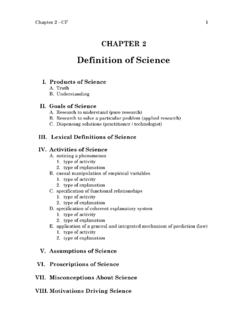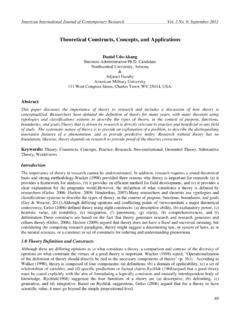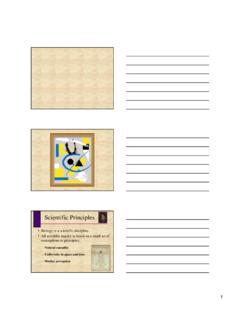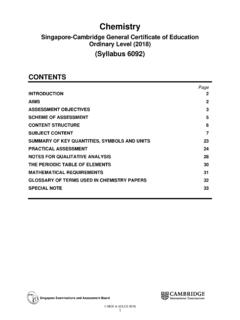Transcription of Introducing Inquiry and the Nature of Science
1 66. Teaching About Evolution and the Natu re of Scie/lce Introducing Inquiry and the Nature of Science This activity introduces basic procedures This activity also provides all students 0 PPOltu . involved in Inquiry and concepts describing the nities to develop understanding about inquily and Nature of Science . In the first pOltion of the activity the Nature of Science as desclibed in the National the teacher uses a numbered cube to involve stu Science Education Standards. Specifically, it intro . dents in asking a question-what is on the bot duces the follOwing concepts: tom?
2 - and the students propose an explanation based on their observations. Then the teacher pre Different kinds of questions suggest different sents the students with a second cube and asks kinds of scientific investigations. them to use the available evidence to propose an Current scientific knowledge and understand . explanation for what is on the bottom of this cube. ing guide scientific investigations. Finally, students design a cube that they exchange Technology used to gather data enhances and use for an evaluation. This activity provides accuracy and allows scientists to analyze and quan.
3 Students with opportunities to learn the abilities tify results of investigations. and understandings aligned with Science as Inquiry Scientific explanations emphasize evidence, and the Nature of Science as described in the have logically consistent arguments, and use scien . National Science Education Standards. DeSigned tific principles, models, and theories. for grades 5 through 12, the activity requires a total Science diStinguishes itself from other ways of of four class periods to complete. Lower grade knowing and from other bodies of knowledge levels might only complete the first cube and the through the use of empirical standards, logical evaluation where students deSign a problem based arguments, and skeptiCism, as scientists strive for on the cube activity.
4 The best possible explanations about the natural world. Standards-Based Outcomes This activity provides all students "vith opportu Science Background for Teachers nities to develop abilities of scientific Inquiry as The pursuit of scientific explanations often described in the National Science Education begins with a question about a natural phenome . Standards. Specifically, it enables them to: non. Science is a way of developing answers, or improving explanations, for observations or events identify questions that can be answered in the natural world. The scientific question can through scientific investigations, emerge from a child's cmiosity about where the deSign and conduct a scientific investigation, dinosaurs went or why the sky is blue.
5 Or the use appropriate tools and techniques to gather, question can extend scientists' inquiries into the analyze, and interpret data, process of extinction or the chemistry of ozone develop descliptions, explanations, predic depletion. tions, and models using evidence, Once the question is asked, a process of scien . think critically and logically to make relation tific Inquiry begins, and there eventually may be an ships between evidence and explanations, answer or a proposed explanation. Critical aspects recognize and analyze alternative explanations of Science include cmiosity and the freedom to and predictions, and pursue that curiosity.
6 Other attitudes and habits of communicate scientific procedures and expla mind that characterize scientific Inquiry and the nations. activities of scientists include intelligence, honesty, skepticism, tolerance for ambiguity, openness to CHAPTER 6 67. Activities for Teaching About EwlutiolJ and the Natll re of Science new knowledge, and the willingness to share phenomena or explaining the likelihood of events knowledge publicly. in actual situations. Scientific Inquiry includes systematic approach SCientific explanations assume cause-effect es to observing, collecting information, identifying relationships.
7 Much of Science is directed toward significant vmiables, formulating and testing determining causal relationships and developing hypotheses, and taking precise, accurate, and reli eA-planations for interactions and linkages between able measurements. Understanding and designing objects, organisms, and events. Distinctions experiments are also part of the inquily process. among causality, correlation, coincidence, and con . Scientific explanations are more than the results tingency separate Science from pseudoscience. of colleCting and organizing data. Scientists also SCientific explanations are limited.
8 Scientific engage in important processes such as constructing explanations sometimes are limited by technology, laws, elaborating models, and developing hypothe for example, the resolving power of microscopes ses based on data. These processes extend, clarify, and telescopes. New technologies can result in and unite the observations and data and, velY new fields of inquily or extend current areas of impOliantly, develop deeper and broader explana study. The interactions between technology and tions. Examples include the taxonomy of organ advances in molecular biology and the role of tech.
9 Isms, the periodic table of the elements, and theo nology in planetary eA-plorations selve as examples. ries of common descent and natural selection. Science cannot answer all questions. Some One characteristic of Science is that many questions are Simply beyond the parameters of sci . explanations continually change. Two types of ence. Many questions involving the meaning of changes occur in scientific explanations: new expla Me, ethics, and theology are examples of questions nations are developed, and old explanations are that Science cannot answer. Refer to the National modified.
10 Science Education Standards for Science as Just because someone asks a question about an Inquiry (pages 145-148 for grades 5-8 and pages object, organism, or event in Nature does not neces 175-176 for grades 9-12), HistOlY and Nature of sarily mean that person is pursuing a scientific expla Science Standards (pages 170-171 for grades 5-8. nation. Among the conditions that must be met to and pages 200-204 for grades 9-12), and Unifying make explanations scientific moe the follOwing: Concepts and Processes (pages 116-118). Chapter 3 of this document also contains a discussion of SCientific explanations are based on empirical the Nature of Science .



